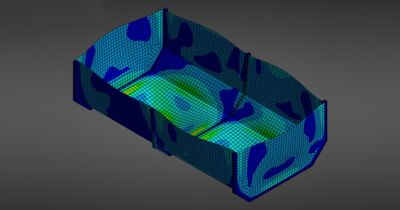In industries such as mining and materials processing, many operations involve mixes of particles interacting with solid systems. To improve efficiency and drive big-picture insights, engineers must be able to understand this complex interaction from every angle. Combining the powers of structural and particle simulation enables you to gain a greater understanding of these processes while also reducing costs and saving time.
When Ansys Rocky particle dynamics simulation software and Ansys Mechanical structural finite element analysis (FEA) software are coupled, the simulation possibilities of both are doubled and countless opportunities are created. Learn how the Rocky software coupling with Mechanical software works, and find out more about cases in which this coupling can maximize your simulations.
Why Couple Structural With Particle Simulation?
Rocky software is a leading discrete element method (DEM) software that has graphical processing unit (GPU) power to accelerate particle dynamics simulations, which makes it possible to work with higher volumes of data in less time. Rocky software can be used to analyze the interaction of millions of particles as they collide with each other and move inside machines that mix, separate, crush, and transport them. Beyond that, Rocky also has in its resources the smoothed-particle hydrodynamics (SPH) method, which captures the dynamics of fluid flow and makes it possible to analyze how each fluid element interacts with particles and wall boundaries.
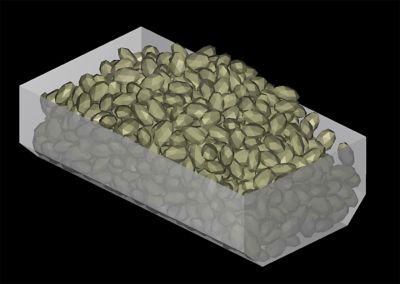
Simulation in Ansys Rocky software
Mechanical software, on the other hand, is a leading FEA solver with structural, thermal, acoustic, and transient capabilities. With Mechanical software, you can solve complex structural engineering problems. The software offers a dynamic environment with a full range of analysis tools with which you can prepare your geometries by connecting additional physics to achieve even higher fidelity. Mechanical software also is known for its customization and scripting capabilities, enabling users to automate repetitive tasks and workflows.

Ansys Mechanical software project
Coupling Rocky software with Mechanical software can provide a more comprehensive and accurate simulation. While Mechanical software is great for structural analysis, Rocky software specializes in particle flow simulations and granular analysis. By integrating both, you can gain a more complete view of system behavior, especially in applications involving complex interactions among solid structures, granular materials, and fluids. This is crucial in industries such as mining, materials processing, pharmaceutical, and other areas in which there are significant interactions among solids, particles, and fluids.
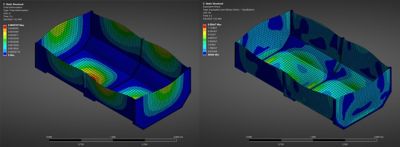
The effects caused by the particles on the surfaces after a one-way coupling simulation between Rocky software and Mechanical software
What Are the Benefits of Particle and Structural Coupling?
Rocky software coupling with Mechanical software offers a more holistic and effective approach to analyze complex systems involving particles, fluids, and solid structures.
- More accurate analysis: This integration allows you to more accurately simulate systems that involve complex interactions among solids, particles, and fluids.
- In-depth understanding: You can gain a more complete view of the system's behavior, better identifying the effects of particles and fluids on solid structures and vice versa.
- Design optimization: By considering the particle and fluid effects from an early design stage, it is possible to optimize the design to improve performance and reduce costs.
- Reduction of physical prototypes: Coupled simulations can help reduce the need for physical prototypes, saving time and resources during the development process.
- Greater efficiency: By integrating both software, you can perform more complete analyses efficiently, taking advantage of the specific capabilities of each software.
Exploring DEM-FEA Coupling Simulations
Coupling Rocky software and Mechanical software solutions enables a more comprehensive and accurate simulation, especially when analyzing the complex interactions among the solid structure, granular materials, and fluids. The software coupling improves structural loading analysis and prediction by calculating stresses, strains, displacements, and heat transfer, ensuring the integrity of components and equipment under DEM and SPH loads.
Several industries and applications can use the software coupling. In the mining industry, it can be applied to truck loading, excavator and forklift operations, and soil preparation. The example below shows the analysis of a transfer chute for the mining industry inside Rocky software. The transient forces caused by the collision of DEM particles on the steel sheets are sent to Mechanical software, which analyzes the stresses and displacements of the steel sheet.
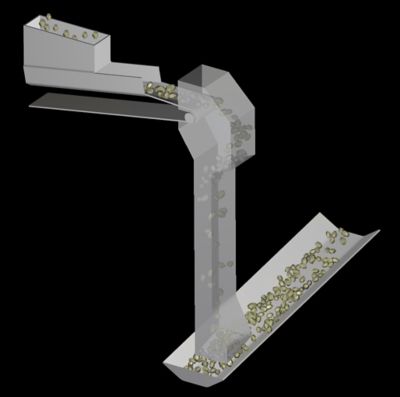
Transfer chute case simulation inside Rocky software
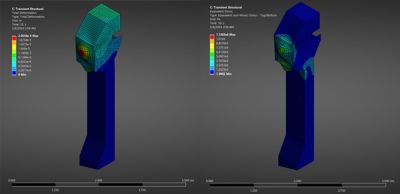
The transfer chute total deformation and equivalent von Mises stress calculated inside Mechanical software
When a piece of equipment interacts with particles — which can be from conveying, sorting, mixing, breaking, and so on — the geometry will undergo certain loads caused by the contact forces with the bulk material. Here, you can use the coupling, and the finite elements analysis from Mechanical software can solve the structure behavior, calculating the acting stresses and deformations caused by the particles loading. An example of this is in the stress and deformation analysis of a backhoe, which is shown below. Here, the movement of the backhoe bucket and its interaction with the DEM particles were simulated inside Rocky software. All collisions then were sent to Mechanical software, which analyzed the reaction and enabled the optimization of the bucket thickness.
The backhoe bucket and its interaction with the DEM particles simulated inside Rocky software, followed by the equivalent von Mises stress and the total deformation of the backhoe bucket calculated inside Mechanical software.
Coupling SPH-FEA Simulation for Fluid-structure Interaction
Just like the DEM-FEA cases shown before, the interaction of SPH with the boundary, whether forces or heat exchange, also can be analyzed in a Rocky software and Mechanical software coupling. The applications are vast as fluid-structure interaction (FSI) commonly is simulated in biomedicine, oil and gas, cooling, and machinery equipment industries. The SPH collision forces and pressure, as well as the heat transfer coefficient (HTC) applied to the geometries, are calculated in Rocky software. The results can be sent to Mechanical software, which calculates all the stresses and deformation of the selected geometry. Additionally, you can send the prescribed temperature calculated from Mechanical software to Rocky software, and this impact on the SPH temperature also can be solved.
A good example of the SPH-FEA coupling is the dam break case, a free course in the Ansys Innovation Space. In the image below, the forces generated by the collision of the volume of fluid (SPH) released toward the fixed column are computed by Rocky software and then sent to Mechanical software, which analyzes the structural deformation stresses.
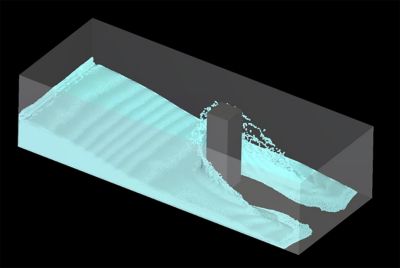
Dam break case simulation in Rocky software
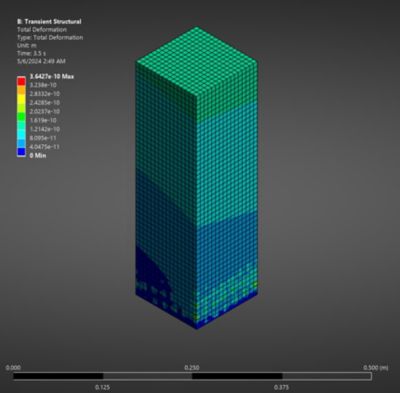
Total deformation caused by the forces generated by the collision between the SPH elements against the column simulated in Mechanical software
You also can apply SPH-FEA coupling to simulate a heat transfer tube, which is presented in our how-to video. In this case, the SPH fluid temperature is calculated using the HTC in Rocky software, and the tube temperature is predefined inside Mechanical software. The heat transfer between the fluid and the boundary can be solved in a Rocky software and Mechanical software two-way coupling. The SPH thermal effects can be postprocessed in Rocky software, and both thermal effects and heat flow also can be visualized in Ansys EnSight simulation data visualization software, as shown below.
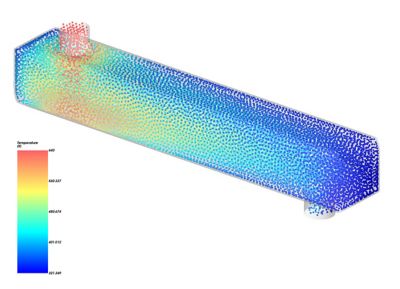
The SPH temperature solved in Rocky software
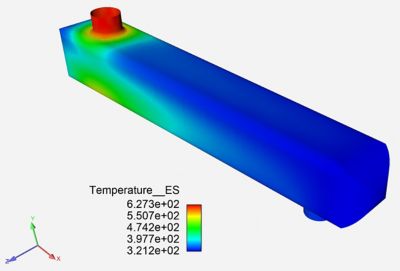
The tube heat transfer calculated by Mechanical software postprocessed in Ansys EnSight software
Optimizing Results Through Particle and Structural Software Coupling
The coupling between Rocky software and Mechanical software is an excellent approach for analyzing the complex interactions among solid structures, granular materials, and fluids. Software coupling improves structural loading analysis and prediction by calculating stresses, strains, displacements, and heat transfer, ensuring the integrity of components and equipment under DEM and SPH loads.
Coupling Rocky software and Mechanical software enables more accurate and comprehensive results, in addition to providing greater understanding by bringing two numerical specialties together in the same simulation. Furthermore, you can reduce the number of prototypes as both DEM-SPH interactions and structural components can be analyzed together. This provides a significant gain in performance and safety in structural integrity results.
Learn more about FEA-DEM coupling in Ansys software through an on-demand webinar. Additionally, you can access Rocky software tutorials 12, 15 and 24 for more information on the use cases mentioned above.














